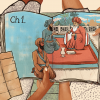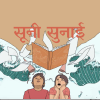This essay studies the social contexts of the Mappilappattu or Mappila song genre in Arabic-Malayalam literature, taking in view two texts in particular. Both these texts fall in the category of padappattu (war songs) that added vigour to the struggle against the colonial regime in the 18th and 19th centuries in Kerala. They are Cheroor Padappattu (1851) written jointly by Muhammedkutty and Muhayyudheen, and Malappuram Padappattu or Madhanidhi Mala (1883) written by Moyinkutty Vaidyar.
Cheroor Padappattu narrates the battle fought against the British under the leadership of Mamburam Saydalavi Thangal at Cheroor in Malappuram district in 1843. The Mappilas joined hands with the oppressed classes of the region and fought against the local representative of the British regime, Kaprattu Krishna Panikkar and his men. It is also recorded as Kaprattu Krishna Panikkar Pattu in William Logan’s Malabar Manual. Malappuram Padappattu chronicles the peasant struggles in Malabar in the 18th and 19th centuries. In 1763, a local landlord, Para Nambi, had a run-in with an officer called Ali Marakkar, who collected taxes on behalf of the British government. Para Nambi conspired to murder Ali Marakkar and this soured the friendly relationship he had with the Muslims of the region. The British authorities and some Nair feudal lords tried to exploit the tense situation and soon it blew up into a full-fledged revolt against the feudal landlords. The Mappilas and the oppressed castes joined in the conflict. History records that 44 Muslims and a lower-caste Hindu died in the revolt. A commemorative event—Malappuram nercha—takes place every year in Malabar. It should also be mentioned here that later Para Nambi repented and extended an olive branch to the Muslims. The Malappuram Padappattu chronicles the conflict, the conspiracy of the colonial powers involved and the reconciliation that followed.
All forms of art and literature that tried to record the resistance against the colonizers were marginalized under the label ‘folk’ during the colonial age. Imperialism asserted itself by designating ‘writing’ as the finest form of literature and denigrating the native artistic and literary forms as oral traditions. As a result, forms of literature transmitted through both oral and written traditions incurred a fatal blow. Sanskrit, which had occupied the highest pedestal when the Aryan peoples established their dominance, was replaced by English during British colonial occupation. Native language systems were labelled primitive and relegated to secondary positions. Different linguistic cultural practices were marginalized even as they took part in the process of building the society and the nation. Various national and sub-national discursive systems were subjected to gradual alienation. These were the social conditions under which the Mappilappattu, the cultural products of the Arabic-Malayalam language, were labelled folk songs. A poetic form like Mappilappattu could survive only by articulating its difference with dominant cultural traditions. Our literary historians generally treat such minor genres with indifference. This was the fate of all literary forms that were cast under the 'country'/'folk' category.
The way in which these marginalized artistic-literary forms survived, fighting a centralized power structure of the times, deserves attention. The study of the social contexts of separate cultural forms has high significance in this regard. It can be noticed that with the advent of the Portuguese, marked by the arrival of Vasco da Gama in Kerala in 1498, the existing socio-political power structures underwent a change in their character. The attitude of the Portuguese to the local people, including the Syrian Christians, was rigid and unkind. Indigenous art forms were almost on the verge of being expelled. European explorers like Vasco da Gama carried out their voyages to unknown shores with papal sanction: the Dum Diversas or papal bull (issued by Pope Nicholas V in 1452, the first such written directive) granted permission to King Alfonso of Portugal to ‘capture, vanquish and subdue the Saracens, pagans, and other enemies, (and) to put them into perpetual slavery’. The Portuguese had uneasy relations with the Muslim peoples in Spain and in their colonies too they continued to view Muslims as their arch rivals. In Kerala this rivalry was intensified by the intimacy of the Samoothiri (Zamorin or the Hindu ruler) of Kozhikode with their Muslim naval chiefs, the Kunjali Marakkars. Moreover, the Arab presence in the region that posed a threat to the Portuguese trade and power equations with the locals, goaded them to selectively attack and slaughter the Muslims/Mappilas. The atrocities that the Portuguese unleashed on the local people are described in Sheikh Zainuddin Maqdhum’s Tuhfatul Mujahideen. This is also the historical background to works like Muhyudhin Mala written in 1607. The influence of Arabic is evident in various Indian languages during this period, most visibly in Bangla, Tamil and Kannada. Even before Muhyudhin Mala was composed in Arabic-Malayalam, such mala songs were written in Arabic-Tamil.
The European tactics of promoting the subservient local kings and the domination of brahminism changed the caste-landlord power equations in Kerala. The Europeans put into practice the homogenizing and territorializing of history. The British considered India their colony but were not willing to bring about changes in the caste system that prevailed here. In short, a situation was created of the domination of elite castes and foreigners working in unison. The state of the other European colonies in the 19th century was not different. It was in the 19th century that the sub-genre of padappattu originated and flourished in Arabic-Malayalam. The tonal and emotional combination in padappattu is quite different from that of other sub-genres of Mappilappattu like malappattu and khissuppattu. The tonality and the emotional timbre of the text help in understanding the relationship between its context and social history. The Mappilas of Malabar, like people of other regions of the world, did move against the British concept of an ‘integrated nation’. We can gauge the intensity of those turbulent times from the historical documents of the period. The Mappilas initiated several minor riots even before the 1921 uprising. Most of these struggles were carried out by lower castes against their feudal landlords and the British rule that protected the former.
William Logan observes in the Malabar Manual that the revolt of 1836 was provoked by the British court which took recourse to the Roman argument that the ownership of the land vested with the landlord, justifying the consequent expulsion of the farmers from their lands. In 1853 the Madras Presidency appointed a Commission headed by T.L. Strange to inquire into these revolts. As permanent solution to the crisis, the Commission suggested strict measures such as seizure of property, exile of those who might form organized groups, stopping gunneries, banning the building of mosques, and forming an army comprising only Hindus. This was, in a sense, a modern legal document that reminds one of the Papal Communiqué in 1452. The Mappila Outrages Act was also passed in the year 1859. The observations made by the then Malabar Collector, William Logan, help us to critically understand, to some extent, the social context of the period. Logan’s words lay bare the falsity of the argument that the riots in Malabar were not farmers’ struggles but communal (Logan1887:644):
The important factor behind the dissatisfaction and distress of the farmers who worked for livelihood under the prevalent system of ownership of land was the grave sense of insecurity they felt under this system. Legal action to affirm security to the farmers, be they of any caste, is required to put an end to their problems. Permanent right of the property and regular income, granted not as a charity but as a right, is ensured legally to the zealous and hardworking farmers—in this it can said that there is none to surpass the Mappillahs—would curb religious fanaticism and the consequent riots.
The colonial justification that the Mappilas were lower-caste converts to Islam is proved wrong by Logan with the help of the census of 1871–81. The essence of Arab nationality and ethnicity certainly played a significant part in the formation of the Muslim cultural and social life in early North Kerala. But as the Muslims came from the native lower castes there is nothing wrong in saying that they represented a social majority. Therefore, Arabic-Malayalam literature combines the qualities of Arabic ethnicity and the sense of resentment against foreign domination. The aesthetic vibrations of the social history of resistance to power structures are palpable in the battle songs of Arabic-Malayalam.
There was a deluge of padappattu in Mappila literature in the 19th century. The two works mentioned at the start of this essay have drawn their subject matter from regional history. Yet it is surprising that these works are seldom mentioned in accounts of the literature of the Kerala renaissance. Social uprisings such as the Channar lahala or Channar riots (1813–59) and the repository of folk songs that fuelled them do not find any place in this history. Even the poems and songs of Poykayil Appachan (Poykayil Yohannan [1878–1935]), a contemporary of Sree Narayana Guru, continue to be unfamiliar to us.
Why is it that the renaissance in Kerala is rendered one-dimensional? Why is it that we are focused only on the art and literature of the elite sections of the society? This shows the degree to which the discourse of exclusion has played its role in our socio-political formation. The multidimensional character of the renaissance in Kerala should be acknowledged after considering the artistic-literary attempts of all castes and religious groups, or else, we would have to agree, our understanding of the Indian renaissance is incomplete.
References
Logan, William. 1887. Malabar Manual. New Delhi: Asian Educational Services










